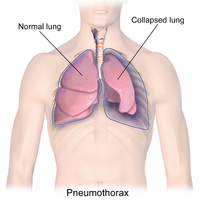
Photo from wikipedia
Background This study aimed to explore the coordinated and independent actions of lung lobes during respiration using quantitative computed tomography (CT) in order to increase our in vivo understanding of… Click to show full abstract
Background This study aimed to explore the coordinated and independent actions of lung lobes during respiration using quantitative computed tomography (CT) in order to increase our in vivo understanding of pulmonary anatomy. Methods Cases for whom test results showed normal pulmonary function tests (PFTs) results, and normal paired inspiratory-expiratory chest CT findings, as assessed by 2 radiologists, were retrospectively included in this study. From the chest CT results, we measured quantitative indices of lung volume (LV) and mean lung density (MLD) for the total lung (TL), left lung (LL), right lung (RL), and 5 lobes in inspiratory and expiratory phases. The differences of these measures between bilateral lungs and among the lobes were evaluated to study whether they were consistent or different during respiration. Results A total of 70 cases were included {median age of 49.5 [interquartile range (IQR), 38.0 to 60.3] years; 32 males; 38 females}. Overall, the inspiratory and expiratory volumes of the LL were smaller than those of the RL (both P<0.001). For the ventilation workload (λ, which indicates the ratio of lobar volume to total LV), the end-expiratory volume ratio (λex ) of the LL was 0.44 (IQR, 0.43 to 0.46), while the end-inspiratory volume ratio (λin ) had risen to 0.46 (IQR, 0.45 to 0.47) (P<0.001). Comparing the 5 lobes, not all lobes shared the same LV. However, the left lower lobe (LLL) and right lower lobe (RLL) showed some similarities. The λin-LLL and λin-RLL was higher than λex-LLL and λex-RLL , respectively (both P<0.001), while the ratios of the other lobes reduced. The pairwise mean absolute difference (PMAD) on λin and λex of the bilateral lower lobes was low in inspiration (0.0288) and expiration (0.0346). The MLD of bilateral lower lobes showed consistency in inspiration or in expiration (inspiration: P>0.999; expiration: P=0.975). In addition, the PMADs between the right middle lobe (RML) and other lobes were significantly larger than the PMAD between other pairs of lobes in both inspiration and expiration. Beyond that, the expiratory MLD of RML [-789.6 (IQR, -814 to -762.05) HU] was the lowest among the 5 lobes. Conclusions We found that the LL assumes a higher workload during ventilation than it does during respiration. The 5 normal lobes were non-synchronous during respiration and contributed differently to ventilation. The bilateral lower lobes showed similarities and had a high-ventilation function, while and the LV and MLD of the RML showed the least changes within a respiration cycle.
Journal Title: Quantitative imaging in medicine and surgery
Year Published: 2022
Link to full text (if available)
Share on Social Media: Sign Up to like & get
recommendations!